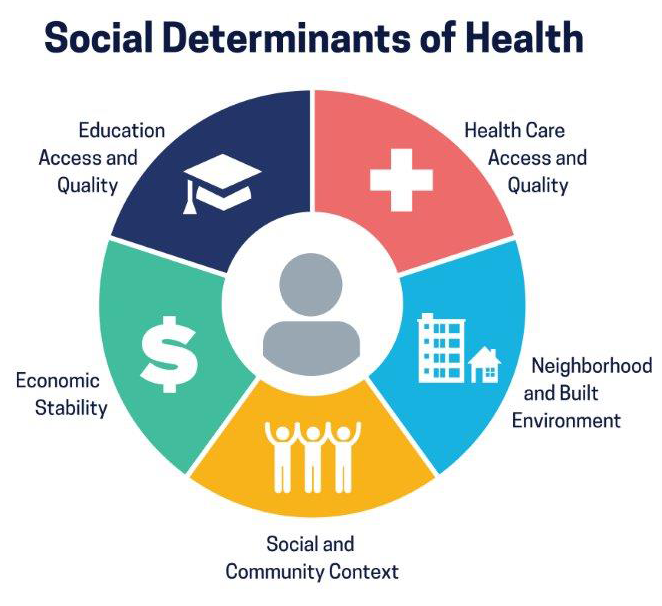Caring for Undocumented Noncitizens: The Palliative Care Team's Role

Who do you imagine when you read or hear the phrase, “undocumented immigrant”? A student who graduated, but overstayed their visa? An adult brought to the country as a child by their parents who could not read English well enough to enroll in programs that would protect their immigration status? Someone hungry for a better life or traveling against their will?
Given the innumerable reasons why people come to the US, the term “undocumented noncitizen (UNC)” has come to replace the terms “undocumented” and “unauthorized”—to reduce the judgments implicit in these phrases.[1]
"UNCs make up 14% of the total uninsured population of the health care system, which can lead to underutilization of care until needs become emergent."
As of 2018, there are approximately 11.4 million UNCs living in the US.[2] However, the Department of Homeland Security estimates that this value is underrepresented by as much as 10-15%.[2] UNCs make up 14% of the total uninsured population of the health care system, which can lead to underutilization of care until needs become emergent.[2] [3] [4] [5] This underutilization leads to poor preventative and follow-up care, lower immunization rates, and an increase in the spread of communicable diseases.[6]
On a macro level, immigration status impacts each domain of the Social Determinants of Health (SDOH), as illustrated in Figure 1, below. Fear of deportation, shame or stigma around illness, poor health literacy, health care rules and regulations, and a lack of financial or social resources are contributing factors that lead to the underutilization of preventative health services.[6] This not only leads to an increase in the use of health systems for emergency care but also causes economic instability and limited educational access. For palliative care clinicians to provide holistic, patient-centered care we must address all aspects of care, including health inequities stemming from immigration.
"For palliative care clinicians to provide holistic, patient-centered care we must address all aspects of care, including health inequities stemming from immigration."

Barriers to Care
Navigating the barriers to care for UNCs is challenging for clinicians and requires an interdisciplinary team (IDT) approach. Restricted insurance coverage, inaccessible community resources, and limited access to health care services are all common barriers clinicians heed when caring for UNCs.
"Restricted insurance coverage, inaccessible community resources, and limited access to health care services are all common barriers clinicians heed when caring for UNCs."
UNCs are distinct from lawful permanent or temporary residents and refugees or asylees, all of whom are eligible for insurance through the Affordable Care Act Marketplace and may be eligible for Medicaid after a waiting period. The Emergency Medical Treatment and Labor Act requires hospitals participating in Medicare to provide a medical screening exam for all patients; however, there is little that is required of health care systems to provide preventative care to reduce emergency visits.[7] Moreover, what constitutes life-sustaining therapies is ill-defined in the legislation, and each state defines it differently. Some states consider cancer therapies to be life-sustaining treatment, others may not, leaving patients to live with all of the symptoms of their illness until the situation becomes emergent.
To complicate the matter further, preventative or maintenance medications, services, and long-term care are often not covered under emergency Medicaid, which contributes to recurrent hospitalizations and increased length of stay.[8] Lack of coverage for patient transport to covered services, such as dialysis, can present an additional challenge.
Barriers to health care access for UNCs extend to care for people living with serious illness. A recent study identified five ways that hospice agencies restricted UNC enrollment and access to care, including:[9]
- Restrictions on the provisions of medications and equipment
- Lack of language and translation services
- Reduced staff visits or reduced access to a full interdisciplinary team
- Restrictions in the setting or level of care
- Reduced duration of service or limiting service to imminently dying patients
These restrictions risk transforming the practice of end-of-life care from a holistic, interdisciplinary, family-focused approach over the last six months of a person's life to a “one and done” visit by a nurse in the last hours to days of life.
Palliative Care Team Considerations
Palliative care clinicians must consider the limitations that UNCs might experience as they navigate the health care system, such as restricted services and medications covered by emergency Medicaid, limited financial resources, and caregiver support.
"Palliative care clinicians must consider the limitations that UNCs might experience as they navigate the health care system [...]"
Additionally, UNCs are less likely to engage in goals of care conversations. Lack of physical family member presence can also complicate complex medical decision-making, leaving clinicians to navigate international calls, varying time zones, and diverse language dialects. Moreover, a transition from the hospital to the community is often affected by state regulations, impairing access to care, supplies, and outpatient treatment. Patients who are not able to be discharged due to these barriers become trapped in a place that was supposed to offer healing, instead causing fear and demoralization. Finally, it is important for clinicians to recognize that UNCs with serious illnesses rely on charity care for palliative care and hospice services.[10] [5]
Strategies to Improve Care
"Palliative care teams can reinforce shared humanity by reminding patients that, “no one is illegal” and everyone is worthy of care."
Palliative care teams can reinforce shared humanity by reminding patients that, “no one is illegal” and everyone is worthy of care. These actions help to establish a positive rapport and a therapeutic alliance in the health care setting. To achieve this, palliative care teams can consider the immigration narrative through the lens of Dame Cecily Saunders’ “Total Suffering” and the use of the following strategies to create an affirming and supportive environment for all patients:[11]
1. Use of professional interpretation services
- Health systems should offer the use of telephonic or video professional interpreter services, rather than using a family member or a clinician who may be fluent in the language
- Encourage other services involved in care to use professional translation services
- Brief interpreter of anticipated content of sensitive topics that will be discussed
2. Incorporate immigration questions in a standard assessment
- What were the circumstances that led to immigration?
- What was life like prior to immigrating? How has it changed?
- What have you accomplished since immigrating?
- How has your illness impacted life changes?
- How do you connect with family members who are in your home country?
3. Assess psychosocial considerations
- Explore fear of deportation (patient, family, caregiver)
- Reinforce confidentiality
- Acknowledge fear of deportation
- Respond with emotional self-awareness[12]
- Generate a preparedness plan with UNC
- How has your illness impacted your ability to work?
- Financial limitations
- Current local caregiver support
- Are there any circumstances throughout your immigration journey that have contributed to feelings of suffering/trauma?
4. Know your local communities
- With diverse and ever-shifting local communities, what populations have taken root in your community?
- What are the cultural and spiritual practices of these groups?
- How do they change between first and second generations of immigrants?
- Approach patients as life-long learners through a lens of cultural humility
5. Understand emergency Medicaid coverage
- Be aware of the emergency Medicaid regulations in your state
- Know the measures that fall under life-sustaining therapies, including services and medications
- Community groups may offer financial support to cover medical costs not covered by emergency Medicaid
6. Establish relationships with community groups
- Know the available agencies that help new and existing members of your community
- Religious centers and community groups may have established volunteer and support networks to offer items, such as durable medical equipment, incontinence supplies, and transportation to and from appointments
- Identify the hospice agencies that offer charity care
7. Engage in goals of care conversations
- UNCs are less likely to engage in planning for the future
- Identify the surrogate decision-maker and involve them early in care
- If the surrogate is outside of the U.S., find the most consistent way to connect with them prior to medical crises
Citations
- ↩ The White House. (2021, January 20). Fact sheet: President Biden sends immigration bill to congress as part of his commitment to modernize our immigration system. [Press release]
- ↩ a b c Baker, B. (2021). Estimates of the Unauthorized Immigrant Population Residing in the United States: January 2015–January 2018. Population Estimates. US Department of Homeland Security.
- ↩ Baugh, R. (2022). Fiscal year 2020 refugees and asylees annual flow report. US Department of Homeland Security, Office of Immigration Statistics.
- ↩ Budiman, A. (2020). Key Findings about U.S. Immigrants. Pew Research Center.
- ↩ a b Metchnikoff, C., Naughton, G., & Periyakoil, V. S. (2018). End-of-Life care for unauthorized immigrants in the U.S. Journal of Pain and Symptom Management, 55(5), 1400–1407.
- ↩ a b Hacker, K., Anies, M., Folb, B. L., & Zallman, L. (2015). Barriers to health care for undocumented immigrants: A literature review. Risk Management and Healthcare Policy, 8, 175–183.
- ↩ Centers for Medicare and Medicaid Studies (2021). Emergency Medical Treatment & Labor Act (EMTALA). Department of Health and Human Services.
- ↩ Rizzolo, K., & Cervantes, L. (2020). Immigration status and end‐stage kidney disease: Role of policy and access to care. Seminars in Dialysis, 33(6), 513–522.
- ↩ Gray, N. A., Boucher, N. A., Kuchibhatla, M., Johnson, K. S. (2017). Hospice access for undocumented immigrants. JAMA Internal Medicine, 177(4), 579–580.
- ↩ Gray, N. A., Boucher, N. A., Cervantes, L., Berlinger, N., Smith, S. K., & Johnson, K. S. (2021). Hospice access and scope of services for undocumented immigrants: A clinician survey. Journal of Palliative Medicine, 24(8), 1167-1173.
- ↩ Wood, J. (2021). Cicely Saunders, 'total pain' and emotional evidence at the end of life. Medical Humanities, medhum-2020-012107.
- ↩ Whitehead, S. A., Montero Hernandez, V. Whitehead, T. (2020). Coping with fear: Counselors achieving professional growth in working with DACA/DREAMers, immigration & refugees. Multicultural Education, 2(3-4), 17-24.

Be the first to read articles from the field (and beyond), access new resources, and register for upcoming events.
Edited by Melissa Baron. Clinical review by Andrew Esch, MD, MBA.

